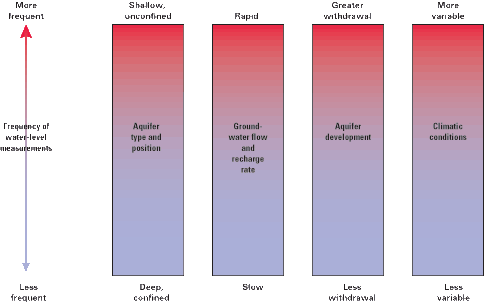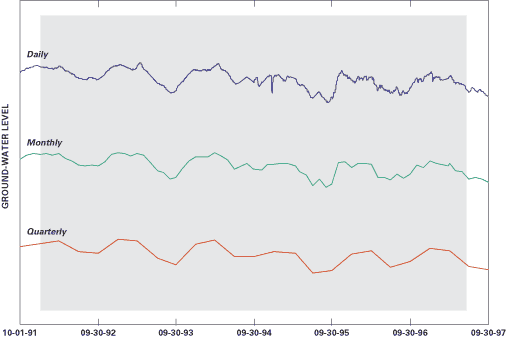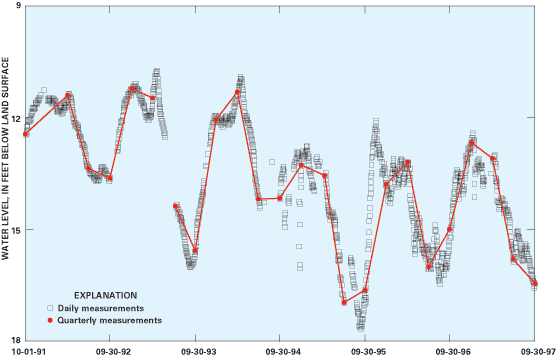
B
Previous Section: Box A
Next Section: Uses and Importance of Long-Term
Water-Level Data
Return to Table of Contents
Return to Home Page
The frequency of measurement is one of the most important considerations in the design of a water-level monitoring program. The development of a plan for water-level monitoring that will be used for each well in the observation network is dependent on the objectives of the program and the intended use and level of analysis required of the data. The frequency of measurement should be adequate to detect short-term and seasonal ground-water-level fluctuations of interest and to discriminate between the effects of short- and long-term hydrologic stresses (Figure B–1).
 |
| Figure B-1. Common environmental factors that influence the choice of frequency of water-level measurements in observation wells |
Water-level monitoring may involve “continuous” or periodic measurements.
Continuous monitoring involves the installation of automatic water-level sensing
and recording instruments that are programmed to make measurements in observation
wells at a specified frequency. Continuous monitoring provides the highest level
of resolution of water-level fluctuations. Hydrographs constructed from frequent
water-level measurements collected with continuous monitoring equipment can
be used to accurately identify the effects of various stresses on the aquifer
system and to provide the most accurate estimates of maximum and minimum water-level
fluctuations in aquifers. For these reasons, it is often advisable that new
observation wells initially be equipped with continuous monitoring equipment
to identify stresses on the aquifer and the magnitude and frequency of water-level
fluctuations. Continuous monitoring may not be required where the hydraulic
response of an aquifer to stresses is
slow and the frequency and magnitude of water-level changes in an observation
well are not great. However, it is often the best technique to use for monitoring
fluctuations in ground-water levels during droughts and other critical periods
when hydraulic stresses may change at relatively rapid rates. Near real-time
data collection also can be accomplished using a continuous recording device
and telecommunication or radio transmitter equipment.
Periodic ground-water-level measurements are those made at scheduled intervals
(weeks, months, or years) and are generally used for water-table or potentiometric
surface mapping and to reduce the costs of long-term monitoring. Periodic water-level
measurements are made by manually using electronic-sensor tapes, chalked metal
tapes, or acoustic sounding devices. Potential drawbacks to periodic monitoring
are that hydraulic responses to short-term stresses may occur between measurements
and may be missed, extreme water-level fluctuations cannot be determined with
certainty, and apparent trends in water levels potentially are biased by the
choice of measurement frequency.
Synoptic water-level measurements are a special type of periodic measurement
in which water levels in wells are measured within a relatively short period
and under specific hydrologic conditions. Synoptic water-level measurements
provide a “snapshot” of heads in an aquifer. Synoptic measurements
commonly are taken when data are needed for mapping the altitude of the water
table or potentiometric surface, determining hydraulic gradients, or defining
the physical boundaries of an aquifer. Regional synoptic measurements made on
an annual or multiyear basis can be used as part of long-term monitoring to
complement more frequent measurements made from a smaller number of wells.
An example of the effects of different measurement frequencies is provided by
water-level hydrographs for an observation well in Massachusetts. The well is
completed in bedrock to a depth of 740 feet, and the characteristics of this
well fall in the middle range of the temporal response categories shown in Figure
B–1.
A daily water-level hydrograph for the Massachusetts well and hydrographs that
would have been obtained for the same well if measurements had been made only
monthly or quarterly are shown in Figure B–2. Comparing
the effects of different measurement frequencies on the hydrographs illustrates
several features. First, monthly water-level measurements for this well generally
are adequate to discern overall seasonal patterns in water levels and long-term
trends but miss some short-term effects from pumping or recharge. Second, unless
quarterly measurements correspond with regular patterns of seasonal variability
of water levels, it can be difficult or impossible to discern anything beyond
simple long-term water-level trends. Figure B–3, which
overlays the daily and quarterly hydrographs from Figure B–2,
illustrates how less frequent water-level measurements lead to lower estimates
of the range of fluctuations in water levels in an observation well.
 |
| Figure B-2. Water-level hydrographs for well PDW 23 in western Massachusetts, based on daily, monthly, and quarterly measurements, plotted to same scale but vertically offset. |
 |
| Figure B-3. Overlaid daily and quarterly hydrographs for well PDW 23 in western Massachusetts. |
[an error occurred while processing this directive]